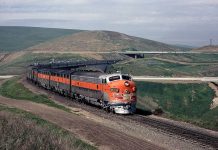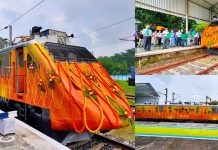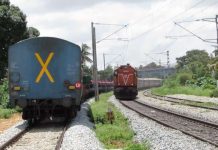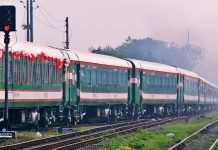What is Push–pull trains?
Push–pull is a configuration for locomotive-hauled trains, allowing them to be driven from either end of the train, whether having a locomotive at each end or not.
A push–pull train has a locomotive at one end of the train, connected via some form of remote control, such as multiple-unit train control, to a vehicle equipped with a control cab at the other end of the train. This second vehicle may be another locomotive, or an unpowered control car.
In the UK and some other parts of Europe, the control car is referred to as a driving trailer (or driving van trailer/DVT where there is no passenger accommodation); in the USA and Canada, they are called cab cars.

Historically, push–pull trains with steam power provided the driver with basic controls at the cab end along with a bell or other signalling code system to communicate with the fireman located in the engine itself in order to pass commands to adjust controls not available in the cab.
At low speeds, some push–pull trains are run entirely from the engine with the guard operating bell codes and brakes from the leading cab when the locomotive is pushing the train.
Many mountain railways also operate on similar principles in order to keep the locomotive lower down than the carriage so that there is no opportunity for a carriage to run away from a train down the gradient and also so that, if the locomotive ever did run away, it would not take the carriage with it.
Modern train control systems use sophisticated electronics to allow full remote control of locomotives. Nevertheless, push–pull operation still requires considerable design care to ensure that control system failure does not endanger passengers and also to ensure that, in the event of a derailment, the pushing locomotive does not push a derailed train into an obstacle worsening the accident. The 1984 Polmont rail crash (in Scotland) occurred when a push–pull train struck a cow on the track.
When operating push–pull, the train can be driven from either the locomotive or the alternative cab. If the train is heading in the direction in which the locomotive end of the train is facing, this is considered ‘pulling’. If the train is heading in the opposite direction, this is considered ‘pushing’ and the motorman or engine driver is located in the alternative cab. This configuration means that the locomotive never needs to be uncoupled from the train and ensures fast turnaround times at a railway station terminus.
Alternatively, a push–pull train, especially a long one, may have a locomotive on both ends so that there is always one locomotive pushing and one locomotive pulling. In this case, caution must be used to make sure that the two locomotives do not put too much stress on the cars from uneven locomotives. It is usual to arrange matters so that the trailing locomotive supplies less power and that the locomotive at the front does more pulling than the locomotive at the rear does pushing. Having an independent locomotive as opposed to a power car at each end is also known in the railway world as a top and tail. When this configuration is used in the US, only one locomotive is allowed to provide head end power (HEP: electricity supply for heating, air conditioning and lighting) to the train. This two-locomotive formation is used by the InterCity 125; its Australian equivalent, the XPT; Amtrak’s Acela; SNCF’s TGV; and New Jersey Transit’s longest Northeast Corridor Line multilevel trains.

This form of operation has not necessarily been a function of train length; sometimes it was the most convenient way to set up push–pull operation in pre-HEP days without converting coaches to cab control operation. A prime example of this was the Reading Company which converted its small fleet of streamstyled heavyweight medium-distance coaches for its non-electric commuter operation, with a pair of EMD FP7 diesels bracketing a single five-car train, to supplant the Reading’s fleet of RDCs. This “pull-pull” steam-heated consist, with a control cable between cars, normally operated a weekday peak-hour round trip between Reading Terminal, Philadelphia and Reading, Pennsylvania, from the late 1960s until 1981, with operation in the last five years by Conrail under contract to SEPTA.
In this configuration locomotives hauling a train are located other than at the front or back. It may include remote control locomotives in the middle of a train. Where operational considerations or economics require it, trains can be made longer if intermediate locomotives are inserted in the train and remotely controlled from the leading locomotive.



















